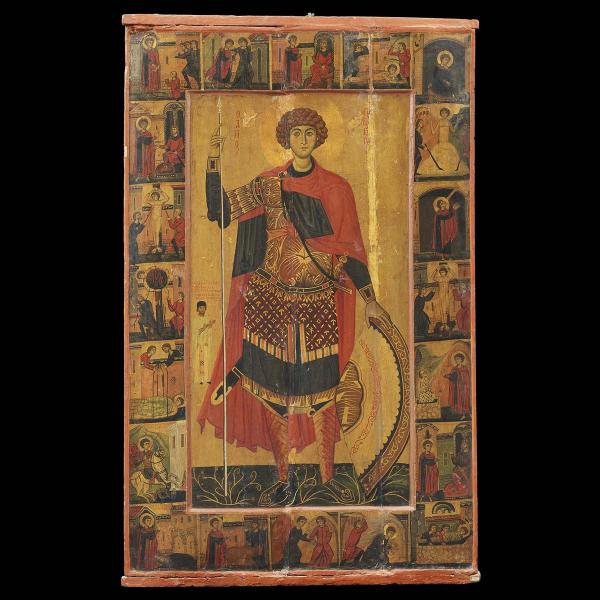Vita Icon of Saint George with Scenes of His Passion and Miracles
Artwork Details
- Title: Vita Icon of Saint George with Scenes of His Passion and Miracles
- Date: early 13th century
- Culture: Byzantine (Egypt)
- Medium: Tempera and gold on wood
- Dimensions: 50 × 31 1/2 × 1 3/8 in. (127 × 80 × 3.5 cm)
- Classification: Paintings-Icons
- Credit Line: The Holy Monastery of Saint Catherine, Sinai
- Curatorial Department: Medieval Art and The Cloisters
Audio

546. Vita Icon of Saint George with Scenes of his Passion and Miracles
Helen Evans, Curator Emerita, The Metropolitan Museum of Art
NARRATOR: This monumental icon is housed in Saint Catherine's Monastery on the Sinai Peninsula, between the Mediterranean and Red Seas. At a location of great significance to people around the world, Saint George, the soldier saint martyred in Syria in the early fourth century, stands with his spear and shield at center. Twenty narrative scenes surround him, including the famous story—at lower left—of him slaying a dragon on a white horse.
Helen Evans is former Mary and Michael Jaharis curator for Byzantine art at The Met, and catalogue contributor and consulting curator for the exhibition.
HELEN EVANS: The holy figure surrounded by scenes from their life, we call them vita icons, life icons, and the suggestion is that you and I would be going to the monastery, and we would be looking at a spot dedicated to Saint George. You would then be told by one of the monks who Saint George was, and he would be able to show you each picture of the miracles that Saint George did, of the various ways that he was tortured.
In the thirteenth century when this was painted the monastery pulled thousands of people, hundreds of people would be visiting at any time. And they would be coming from all over the Christian known world.
NARRATOR: Pilgrims traveled for weeks or months from as far as France and Ethiopia to see Sinai, a place of deep Christian significance. It’s where the prophet Moses spoke to God in the burning bush and received the tablets of the law on the mountaintop. The monks of Saint Catherine’s were accustomed to receiving these pilgrims, regardless of their ethnic or linguistic background.
EVANS: So you get the life of Saint George spoken to you by the monk who can speak Ethiopian or the one who can speak Latin. Today if you go to the monastery, there are different monks who take different pilgrims around according to which languages the monks can speak.
So, it’s important to see it as the famous American phrase; it’s a melting pot.